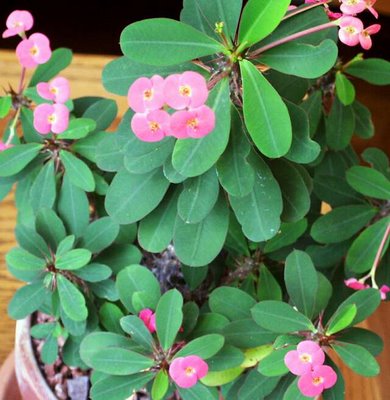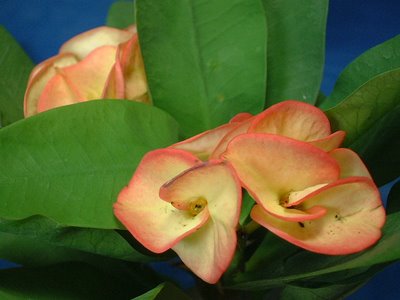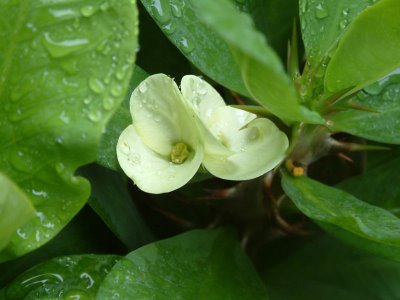Spurges (Euphorbia)

Common name: Crown Of Thorns
Spurges (genus Euphorbia) are a very large and diverse worldwide group of plants, belonging to the spurge family, or Euphorbiaceae. The botanical name Euphorbia derives from the Greek Euphorbus, physician of king Juba II of Numidia (52-50 BC - 23 AD), in whose honour – or in allusion to his swollen belly – a certain plant he might have used, possibly Euphorbia resinifera, was named. In 1753 Carolus Linnaeus assigned the name to the entire genus.

This delightful little shrub, only slightly succulent, is very popular as a houseplant, and deservedly so, as it is more suited to a well-lit living-room window in winter than to the average colder green house, where it will certainly lose its long leaves, and probably its life also!

Like all members of the family Euphorbiaceae, all spurges have unisexual flowers. In Euphorbia these are greatly reduced and grouped into cyathia called pseudanthia. There are also (monoecious) species with male and female flowers on the same plant and those (dioecious) with male and female flowers occurring on different plants. It is not unusual for the central cyathia of a cyme to be purely male, and for lateral cyathia to carry both sexes. Sometimes young plants or those growing under unfavourable conditions are male only, and only produce female flowers in the cyathia with maturity or as growing conditions improve. The bracts are often leaf-like, sometimes brightly coloured and attractive, sometimes reduced to tiny scales. The fruits are three (rarely two) compartment capsules, sometimes fleshy but almost always ripening to a woody container that then splits open (explosively). The seeds are 4 angled, oval or spherical with or without a caruncle.

The plant's great attraction is its brilliant scarlet flower-like bracts, about 1.5cm across, produced freely in spring and summer. There is also a yellow version.
The latex (milky sap) of spurges acts as a deterrent for herbivores as well as a wound healer. Usually it is white, but in rare cases (e.g. E. abdelkuri ) yellow. As it is under pressure, it runs out from the slightest wound and congeals within a few minutes of contact with the air. Among the component parts are many di- or tri-terpen esters, which can vary in composition according to species and in some cases the variant may be typical of that species. These terpen ester determine from species to species if the latex is slightly or very caustic and irritating to the skin, and especially if in contact with mucous membranes (eyes, nose, mouth) can produce extremely painful inflammation. In experiments with animals it was found that terpen ester resiniferatoxin had an irritating effect 10,000 to 100,000 times stronger than capsaicin, the "hot" substance found in chillies. Terpen ester was also found to be carcinogenic. Therefore handling spurges needs to be done with caution. Latex coming in contact with the skin, should be washed off immediately and thoroughly. Partially or completely congealed latex is often no longer soluble in water, but can be removed with an emulsion (milk, hand-cream). With inflammation of a mucous membrane a doctor needs to be consulted. If cutting large succulent spurges in a greenhouse, it has been noticed that vapours from the latex spread and can cause severe irritation to the eyes and air passages several metres away. Caution is therefore required and for example ensure sufficient ventilation. Small children and domestic pets should never come into contact with spurges.

If the stems become too long, encourage more bushy growth by cutting them down to size; this also provides ample cuttings for spare plants. Keep any sap away from your eyes or mouth.
Let the pieces dry for a few days and pot up; they should root fairly easily in spring and summer. Grow this euphorbia in any good loam- or peat-based potting mixture, and water freely in spring and summer. Avoid cold draughts in winter.







0 Comments:
Post a Comment
<< Home